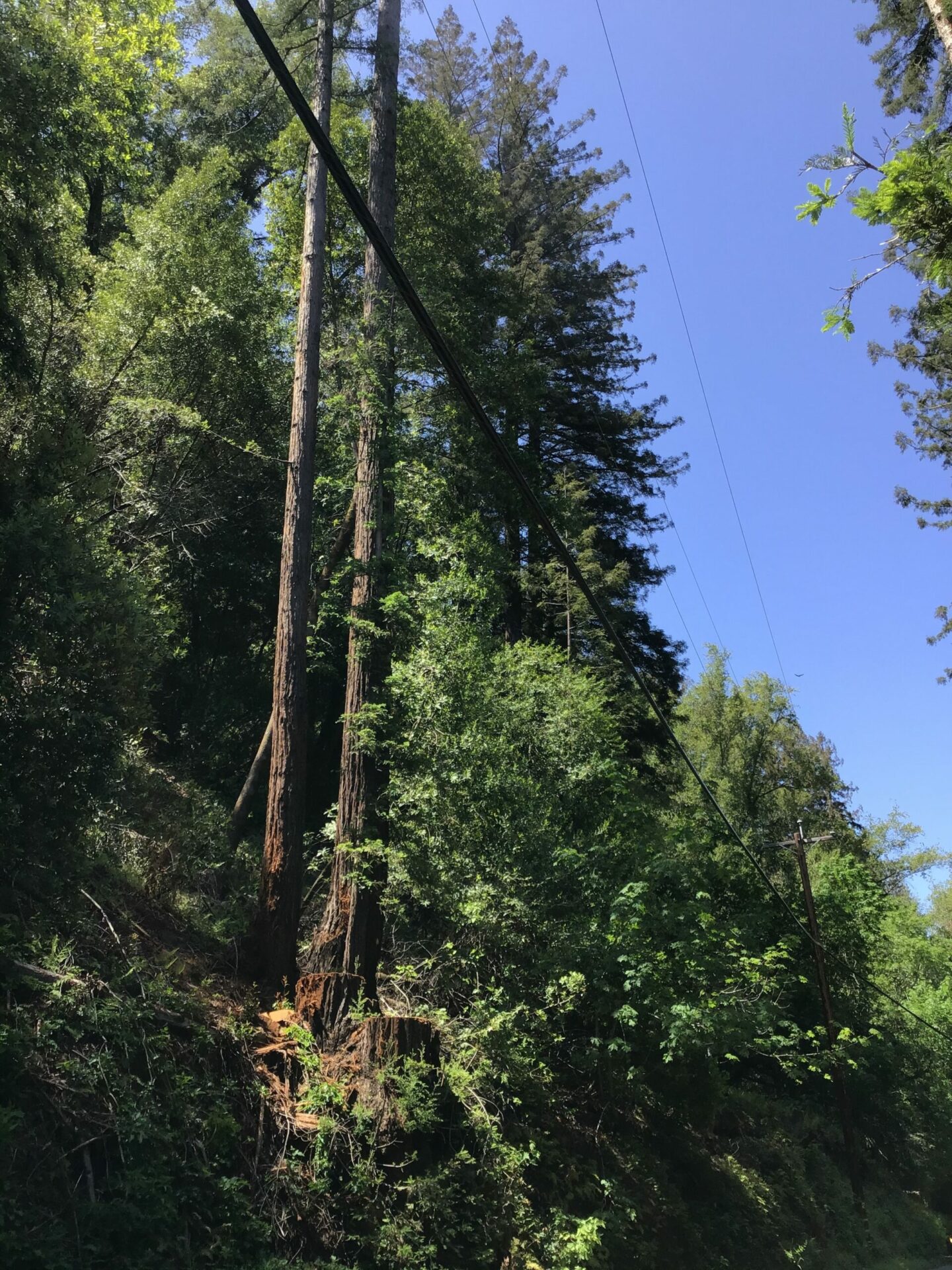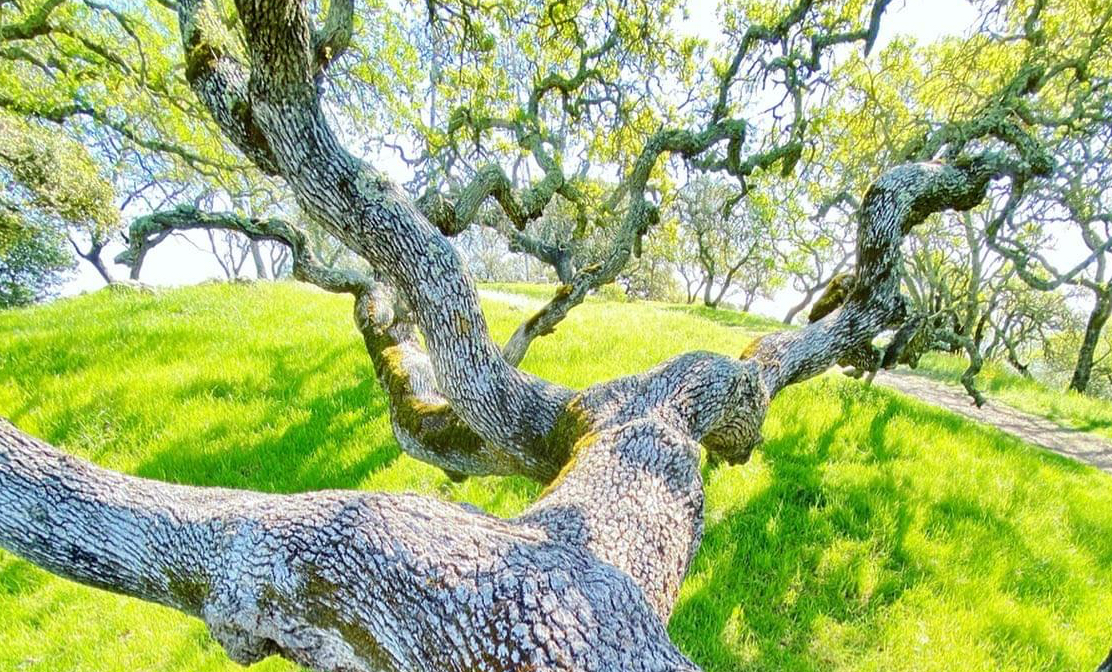Tears for Trees
Pickup passing the severed limbs and body parts of an ancient oak under the Redwood Road power line in Napa County. Photo: Ariel Okamoto.
My family sold a property in the Napa wildland interface in 2019 and it felt like we got lucky. After forty years and two generations on the ridgetop, we were land rich and cash poor, and after the 2017 firestorm all around us it was clear it would take heaps of money to weather the future in this at-risk corner of the wine country.
Since we stayed on in one house as renters, however, I’ve been able to observe first-hand the army of white trucks topped with cranes and chippers deployed to remove the oaks, redwoods, bays and manzanitas from around the power lines on our mountain. The main access road to the big asset at the end — the Christian Brothers monastery and the Hess-Persson winery — got a lot of attention from this steamrolling vegetation management machine. The proximity of that asset probably saved our little property in 2017. Clearing and fire proofing on a landscape scale after that could save it in the future. Regardless, it’s still heartbreaking to see 200-hundred-year-old oaks in heaps and lopsided redwoods — limbless on one side, fully branched on the other, like a wire brush.

Redwood grovelet reduced by half in Napa County. Photo: Ariel Okamoto.
I asked PG&E for some numbers on what they’ve been up to in what they call “High Fire-Threat Districts” across Napa County. According to their North Bay spokesperson Deanna Contreras, PG&E spent approximately $1.06 billion dollars in 2019 and $1.4 billion in 2020 on vegetation management programs along transmission and distribution lines across Central and Northern California, which included routine and compliance work, work to mitigate trees impacted by the drought and bark beetle infestation, and work in high fire-threat areas. They have also granted nearly $17 million to local Fire Safe Councils since 2014, including the Napa Firewise Foundation.
Of course, I know that this great tree slaughter is all in the interests of public safety and fire safety, and that our human development of these landscapes has prevented historic natural fire in ways that could have prevented the current culling. And I also know that when power lines blow down on a red flag day, the results can be deadly and costly, and that nonetheless people resent the public safety power shutoffs.
Other Recent Posts
Who Will Inherit the Estuary? Training for a Rough Future
The six-month program teaches students aged 17 -24 about the challenges facing communities around the SF Estuary, from Stockton to East Palo Alto.
Split Verdict Over State of the Estuary
Habitat restoration and pollution regulations are holding the Bay steady, but the Delta is losing some of its ecological diversity, says SF Estuary Partnership scorecard.
Volunteers Catch and Release Tiny Owls For Science
In Santa Rosa, citizen scientists capture northern saw-whet owls to help further research on climate impacts to the bird.
Antioch Desalination Plant Could Boost Local Water Supply
The $120 million plant opened this fall and treats 8 million gallons of brackish water a day, 75% of which is drinkable.
How Cities Can Make AI Infrastructure Green
Data centers fueling AI can suck up massive amounts of energy, water and land, but local policies can mitigate the impact.
What to Know about PFAS in Tri-Valley Water
In this nonfiction comic, explore how the city of Pleasanton is dealing with PFAS- contaminated groundwater.
ReaderBoard
Once a month we share reader announcements: jobs, events, reports, and more.
Artist Repurposes Shoreline Detritus
Courtney Griffith scours beaches and parks for everything from plastic to charcoal, mangled ropes and burnt wood to use in her work.
After The Fire: Scenes from Chinese Camp
One of California’s oldest Gold Rush settlements takes stock after a devastating fire — a photo essay.
Youth Group Tackles Heat Islands in Santa Rosa
A new youth advisory team convened by the Greenbelt Alliance and Latino Service Providers is exploring heat disparities in southwest Santa Rosa.

We will be seeing those white trucks, both PG& E and their contractors, in our neighborhoods and on our rural roads for decades to come no doubt. According to Contreras, PG&E prunes or cuts down more than 1 million trees annually to maintain clearance from powerlines.
Everyone blames PG&E for poor maintenance and fire losses but rarely owns our own addiction to electricity as a root cause. We want that electricity, that high-speed internet, and we deserve it, right? Even if we live in a remote fire-prone canyon down a dirt road in the coastal mountains. On our buzz cut ridgetop, I mourn the trees.
Healthy blue oak in Rockville Hills Regional Park in Fairfield, near the eastern extent of the 2017 Atlas Peak Fire. Photo: Robin Meadows.









